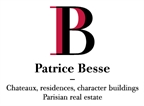45 kilometres southeast from Paris, a 12th-century manor, entirely restored, with its moats, outbuildings and 4.7-hectare grounds - ref 874229
45 kilometres southeast from Paris, a 12th-century manor, entirely restored, with its moats, outbuildings and 4.7-hectare grounds.
To the west of Ile-de-France, in the Seine-et-Marne department, the property is located 45 kilometres southeast of Paris and 20 kilometres south of Marne-la-Vallée with its famous amusement park. In the Brie countryside, which alternates between fields and forests, this determined village was able to resist the assaults of developers and conserve its tranquillity and authentic architecture.
A high-speed rail train station is accessible in 15 minutes by car. The first villages with essential services, facilities and shops are only a few minutes drive away.
Behind the wrought-iron fence, the property is revealed in all its splendour. To the left, the former watchtower, once defensive in nature, seems to welcome visitors today. Across from it, the manor stands facing a vast lawn. Behind it, a paved patio looks out on the former moats, partially encircled by stone ramparts. To the northwest, an apartment located in a semi-detached barn completes the whole. Two driveways provide access to the grounds.
The group of buildings harmoniously blend together thanks to their pointed exposed stone façades, pierced with rectangular or arched windows and embellished with wooden window frames and doors. The window surrounds are in ashlar stone, which match the colour of the plaster. The flat-tile gabled roofs are perforated with pedimented hayloft dormer windows. Corner and façade wall ties are in white or grey ashlar stone.
The first vestiges of the manor date back to the 12th century. Subsequently and through the unification of several fiefdoms and domains in 1787, the construction started to resemble "a fortified house consisting of a group of dwellings and large moats of water". The manor still contains many elements that bear witness to its long history.
The ManorThe building was built over three levels and is composed of a main structure flanked by a square tower on its northwest corner, which in all likelihood was linked to the entrance tower by a high wall, thus forming a fortified whole.
An external roofed staircase runs the length of the main façade, facing east and providing access to the first floor from the outside. Behind the house, wide French doors provide access to the paved patio.
The main entrance is a wooden door reinforced with wrought-iron hinges decorated with leaf patterns set into an arched bay with an ashlar stone frame. A suspended light fixture overhead illuminates the front door on dark nights.
The ground floor
The entrance opens onto a foyer with a stone floor and plaster-coated walls. To the right, the main straight wooden staircase leads upstairs. To the left, a wooden door sculpted in Renaissance-inspired patterns opens onto a large room whose vaulted ceiling is supported by eight stone columns. On each side, large windows flood the room with light throughout the day. Three large arched French doors open onto the back paved patio. Two imposing brick fireplaces framed with sculpted stone pillars face each other from either end of the room.
A wooden door sculpted with linenfolds provides access to a hallway that leads to a lavatory on the right and a vaulted living room on the left, which is bathed in light by a bull's-eye window and decorated with a stone fireplace. The floor is covered in octagonal terracotta tiles. A wooden door leads outside, while a timber-framed staircase provides upstairs access.
Back in the entrance hall, a door leads to a second corridor with a door to the garden. Another door opens onto an initial unfinished kitchen with an exposed beam ceiling, while the next door leads to a second, entirely fitted kitchen, flooded in light by a picture window opening onto the paved patio located in the back. A door provides access ...


